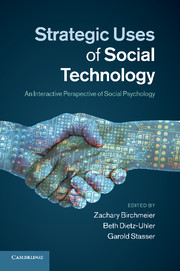Book contents
- Frontmatter
- Contents
- Figures
- Tables
- Notes on the contributors
- Acknowledgments
- 1 Introduction
- 2 A SIDE look at computer-mediated interaction
- 3 Trust, deception, and identity on the internet
- 4 An interactional approach to social influence in computer-mediated communication
- 5 Social interaction in cyberspace
- 6 Dynamics of leader emergence in online groups
- 7 Ostracism in cyberspace
- 8 Opinion-based groups
- 9 A juxtaposition of social influences
- 10 The virtual social world
- Index
- References
5 - Social interaction in cyberspace
Social construction with few constraints
Published online by Cambridge University Press: 07 October 2011
- Frontmatter
- Contents
- Figures
- Tables
- Notes on the contributors
- Acknowledgments
- 1 Introduction
- 2 A SIDE look at computer-mediated interaction
- 3 Trust, deception, and identity on the internet
- 4 An interactional approach to social influence in computer-mediated communication
- 5 Social interaction in cyberspace
- 6 Dynamics of leader emergence in online groups
- 7 Ostracism in cyberspace
- 8 Opinion-based groups
- 9 A juxtaposition of social influences
- 10 The virtual social world
- Index
- References
Summary
No doubt, social interactions supported by modern technologies have become an important part of our personal, professional, and political lives. At least since the last decade social psychologists have become interested in studying interactions that are mediated by modern technologies such as the internet. Research topics have focused on how computer-mediated interactions differ from traditional face-to-face interactions. One aspect that has drawn a lot of attention is that computer-mediated interactions have greater potential for anonymity. As a consequence, many studies have focused on the effects of whether or not the actor is identifiable to the people she is interacting with, referencing the SIDE model (Spears et al., 1990, 2001). SIDE stands for Social Identity De-individuation Effects. The model proposes that social identity moderates the effects of anonymity. It proposes that deindividuation can accentuate social influence when one identifies strongly with an online group but reduce social influence in the absence of strong identity.
When studying social interactions that are supported by new technologies, there is an inclination to start with the premise that social behavior is in some or all ways fundamentally different as a result of the technology. A notable exception is the research on the SIDE model, which started with the position that deindividuation and social identity have been studied in social psychology at least over the last three decades (Diener, 1977, 1979), and that we could learn from applying what we know from these research traditions to advance our understanding of the role of anonymity in computer-mediated interactions.
- Type
- Chapter
- Information
- Strategic Uses of Social TechnologyAn Interactive Perspective of Social Psychology, pp. 84 - 107Publisher: Cambridge University PressPrint publication year: 2011
References
- 2
- Cited by

